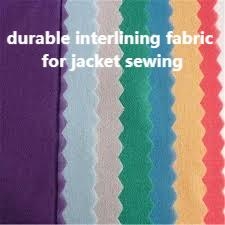Interlining-Factory Sustainable Solutions Blueprint: Eco-Friendly Garment Reinforcement

In garment construction, selecting the proper Interlining is crucial for maintaining structure, shape, and longevity. A well-chosen Interlining ensures fabrics behave consistently during production and retain a polished look throughout the garment's lifespan. Designers and manufacturers rely on these materials to create professional finishes, support tailored designs, and enhance wearer comfort, making them a key element in high-quality apparel.
Types and Characteristics
The textile industry offers a variety of supportive materials that differ in weight, flexibility, and stiffness. Woven options provide strong, rigid support suitable for collars, cuffs, and tailored jackets, whereas non-woven varieties offer lightweight, easy-to-apply solutions for shirts and casual clothing. Knit materials combine elasticity and stability, allowing for stretch applications and activewear designs. Choosing the correct type depends on garment style, desired drape, and production techniques.
Fabric Pairing and Integration
Compatibility with the main fabric is essential to avoid puckering, distortion, or uneven surfaces. Natural fibers like cotton and silk interact differently with supportive layers than synthetics or blends, requiring careful selection to maintain both appearance and comfort. Application methods vary, including adhesives, sew-in layers, or hybrid techniques, each offering advantages depending on production speed and precision. Proper integration ensures garments maintain a high-quality finish across multiple uses and washes.
Performance and Durability
Garment longevity depends on how supportive materials handle stress. Heat, moisture, and repeated handling can compromise structural elements if materials are poorly chosen. Testing for shrinkage, stretch recovery, and resistance to washing or pressing helps identify reliable options. Strong, durable layers prevent deformity in collars, lapels, and cuffs, contributing to a polished appearance and longer garment life, ultimately reducing replacement costs and customer complaints.
Design Flexibility and Fashion Applications
Supportive layers enable creativity by allowing designers to achieve sharper silhouettes, pleats, and complex shapes. Structured garments benefit from layers that provide reinforcement without adding bulk, while soft-support options allow for fluidity in drapes and casual wear. The right balance between stiffness and flexibility supports intricate designs, seasonal collections, and high-end fashion pieces while ensuring production efficiency in factories and workshops.
Sustainability and Responsible Sourcing
Environmental responsibility is increasingly important in textile production. Choosing materials made from recycled fibers, biodegradable components, or sustainable manufacturing practices reduces the ecological footprint of garments. Minimizing waste and offering refillable or reusable options aligns with consumer expectations and regulatory requirements. Transparent sourcing and adherence to sustainability certifications support corporate social responsibility initiatives and appeal to eco-conscious consumers seeking quality products.
Supply Chain and Quality Assurance
Consistency from suppliers ensures uniform performance across production batches. Reliable sourcing, clear technical data, and quality-control protocols help prevent defects and maintain efficiency. Assessing lead times, production flexibility, and traceable documentation ensures that garments retain their intended structure from initial assembly to final retail delivery, improving brand reputation and customer satisfaction.
Selecting the appropriate support materials is fundamental to professional garment construction, enhancing comfort, appearance, and durability. Detailed guidance on types, applications, and sourcing options is available at https://www.interlining-factory.com/news/what-is-interlining-types-applications-and-more.html
- Art
- Causes
- Crafts
- Dance
- Drinks
- Film
- Fitness
- Food
- Jeux
- Gardening
- Health
- Domicile
- Literature
- Music
- Networking
- Autre
- Party
- Religion
- Shopping
- Sports
- Theater
- Wellness

